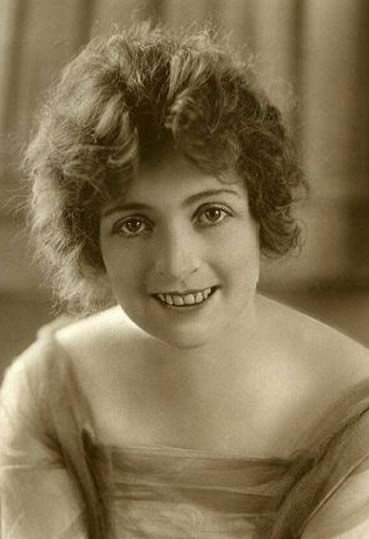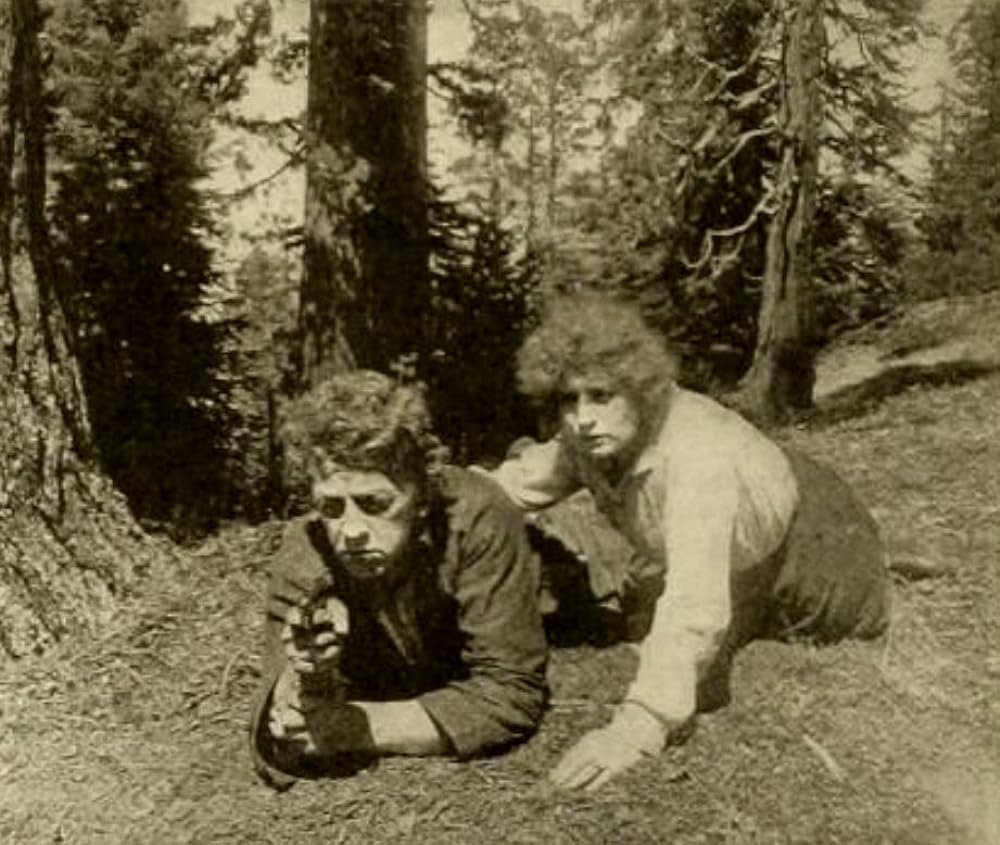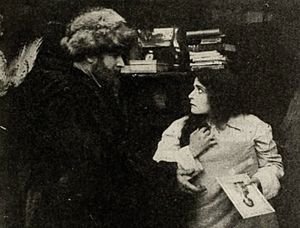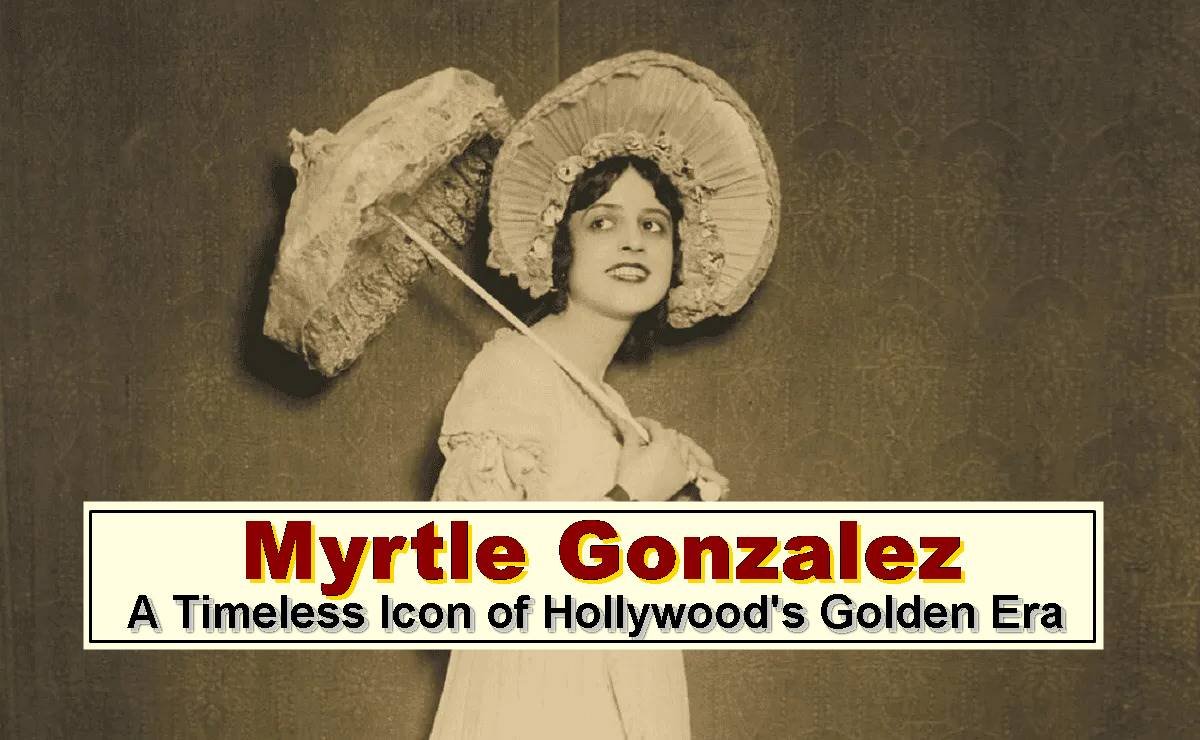Myrtle Gonzalez, also known as the “First Latin American Movie Star,” pioneered the early days of Hollywood. She was born to Mexican immigrants on September 28, 1891, in Los Angeles, California, and her journey to fame was extraordinary.
Myrtle developed a strong interest in entertainment and performance from a young age. She began performing and dancing at local events, quickly gaining fame for her talents. Her breakthrough occurred when director Thomas Ince discovered her during a local theater production.
At 19 years old, Myrtle made her film debut in the silent western “The Invaders” (1912). It marked the beginning of her Hollywood career, where she appeared in over 80 films in the following decade, including “The Easter Lily” (1915), “The Serpent” (1916), and “One Law for Both” (1917).
Her beauty and charm captivated audiences, earning her the title “La Unica” or “the unique one.” Myrtle frequently portrayed vibrant comedy and charisma in her roles, making her a highly adored actor.
Beyond her talent, Myrtle was also a trailblazer for women in the film industry. At a time when female actors were often stereotyped as damsels-in-distress or femme fatales, Myrtle took on vivacious roles that challenged gender stereotypes.
Early Life and Career Beginnings


Myrtle Gonzalez was born on September 28, 1891, in Los Angeles, California, as the youngest of five children to Mexican immigrants Francisco Gonzalez and Maria Rodriguez. Her father worked as a carpenter, while her mother was a housekeeper.
Growing up in the diverse neighborhoods of Los Angeles exposed Myrtle to various cultures and languages. She learned Spanish from her family and English from her classmates.
At 14, Myrtle’s life took a new direction when she encountered a vaudeville group performing at her school. Intrigued by the stage, she convinced her parents to let her become an assistant, sparking her passion for acting.
READ ALSO: Pinayflix: Your Gateway to Filipino and International Entertainment
Career Beginnings
Myrtle honed her acting skills by performing in local theaters across Los Angeles and mastering various dance styles, including flamenco and ballet.
In 1911, at 20, Myrtle received her first film role in “The Immigrant,” directed by D.W. Griffith. Although a minor supporting role, it began her successful acting career in Hollywood.
Over the following decades, Myrtle appeared in numerous silent films, including “The Little American” (1917) alongside Mary Pickford.
Rise to Fame in Silent Films


Myrtle Gonzalez, also known as “The Virgin of the Silver Screen,” rose to fame in the early 1900s due to her remarkable performances in silent movies. Despite starting with minor roles and limited opportunities for Hispanic actors, her talent and determination propelled her to become one of the leading actresses of her era.
Born on September 28, 1891, in Los Angeles, California, Myrtle was raised by her Spanish mother and American father. Growing up in a multicultural community, she discovered her passion for acting early on and frequently participated in local theater productions. Her grace and elegance caught the attention of director Mack Sennett, who offered her a chance to join Keystone Studios.
In 1913, Myrtle made her cinematic debut in the short film “Giving Them Fits.” Although a minor role, it marked the beginning of a two-decade-long career. Her fame grew thanks to her expressive eyes and the ability to convey emotions without uttering words. It led to prominent roles in feature films such as “Love’s Forgiveness” (1915) and “The Silent Witness” (1917).
Her household name status came when she starred alongside the renowned comedian Roscoe “Fatty” Arbuckle in “Fatty’s Plucky Pup” (1915). Their on-screen chemistry was undeniable, and they remained famous throughout their careers.
Personal Life and Relationships

Myrtle’s personal life and relationships significantly influenced her growth as an actress and an individual. Born on September 28, 1891, in Los Angeles, California, to Mexican parents, she was exposed to the world of theater from a young age, as her father was an actor and her mother an actress.
Myrtle had a close bond with her family as a child, often accompanying her parents to their performances. At 16, she made her stage debut, receiving acclaim and praise for her acting talent. However, it was in the world of film that she gained widespread recognition.
In terms of her romantic life, Myrtle had two marriages. Her first marriage was to silent filmmaker George Marshall in 1913. They remained together for six years but eventually divorced due to personal differences. 1929, Myrtle married cinematographer Allen McNeil, and their marriage lasted until his passing in 1950.
Despite the challenges in her personal life, Myrtle maintained a positive outlook and remained dedicated to her profession. She had strong relationships within the film industry, including co-stars Dolores Del Rio and Ramona Novarro.
Myrtle’s style, both on and off the screen, often garnered media attention. She became a silent film era fashion icon known for her unique style.
Legacy of Myrtle Gonzalez
Myrtle Gonzalez’s legacy continues to influence and inspire generations of actresses and actors in the film world. As one of the first Mexican-American actresses to succeed in Hollywood, she paved the way for future Latinx actors, breaking down barriers to representation in the entertainment industry.
Born on September 28, 1891, in Los Angeles, California, Myrtle Gonzalez was destined for fame from an early age. Her mother was a theater actress, and her father was a renowned director. Unsurprisingly, Myrtle developed a passion for theater at a very young age, making her stage debut at three and continuing to perform throughout her early years.
Upon completing high school, Myrtle decided to pursue a full-time acting career. She received minor roles in various silent films before catching the attention of film director Thomas Ince. Recognizing her potential, Ince cast her lead in “A War-Time Widow” (1915), marking her breakthrough to fame and establishing her as a top actress in Hollywood.
Her natural acting skills, combined with her beauty, earned her the nickname “The Virginian Beauty,” inspired by her role in “The Virginian” (1914). In the 1910s, she shared the screen with some of Hollywood’s most famous actors, including Douglas Fairbanks Sr. and William S. Hart.
Controversies and Scandals
Like many famous figures, Myrtle Gonzalez was not immune to scandals and controversies despite her success in Hollywood.
One of the most prominent controversies involved her relationship with director Herbert Blanche. In the early days, Blache married actress Alice Guy-Blache, a pioneer in early cinema. However, he became romantically involved with Myrtle, leading to his separation from Alice around 1922. This scandal caused a significant stir in Hollywood and affected Myrtle and Blanche’s reputations.
Another issue that dogged Myrtle Gonzalez throughout her career was related to her Mexican heritage. Despite being born in Los Angeles and having Spanish ancestry, she faced discrimination due to her appearance and name. In an era when Mexican Americans were not widely recognized in Hollywood, Myrtle struggled to escape stereotypes such as “the exotic temptress” or “the fiery Latina.”
Additionally, rumors about Myrtle’s romantic life swirled. She was known for her flirtatious on-set behavior. She was linked to several co-stars: one rumored relationship involved actress Francis X. Bushman, one of Hollywood’s biggest stars at the time. While the relationship was never confirmed, the rumor generated controversy since Bushman was married then.
Influence on Hollywood and Pop Culture
Myrtle Gonzalez, known as “the American Beauty,” left an indelible mark on Hollywood and pop culture despite her relatively short career in the 20th century’s silent film era.
Her rise to fame began with her debut in “The Count of Monte Cristo.” Her stunning beauty and captivating presence immediately captured the attention of audiences and critics alike. With each new role, her popularity grew, establishing her as one of the most sought-after actresses of her time.
Myrtle’s influence on Hollywood is evident in her groundbreaking efforts to redefine the portrayal of female movie characters. Before her, female characters were often depicted as damsels in distress or femme fatales. Myrtle brought depth and complexity to her characters, challenging societal norms and paving the way for future female actors.
Additionally, she was a pioneer in advancing Latinx representation in Hollywood. As one of the first successful Mexican-American actors, she shattered barriers and opened track for performers from diverse backgrounds. Myrtle challenged stereotypes and demonstrated that individuals from different cultural backgrounds could thrive in an industry dominated by white actors.
Myrtle’s influence extended beyond Hollywood, profoundly impacting pop culture during her time. Her beauty was adored by fans across America, leading to fashion trends inspired by her unique style. From hairstyles to clothing, her fashion sense became iconic among young girls seeking to emulate her.
Remembering Myrtle Gonzalez: Honors and Tributes
Myrtle Gonzalez, the first Latin American movie star, was a gifted actress whose legacy continues to be celebrated and honored. Despite her tragically short life, her contributions to the film industry remain cherished and recognized.
This segment will explore the awards and tributes bestowed upon Myrtle Gonzalez over the years, from prestigious accolades to commemorative events, highlighting how her impact on film endures.
Posthumous Awards
Despite her untimely passing at 27, Myrtle Gonzalez’s talent was acknowledged through posthumous awards. Photoplay Magazine awarded her a Bronze Plaque for her memorable performance in “The Mexican.”
In 1920, Alma de Mexico magazine honored her with a special award, recognizing her as “the most beautiful woman in Mexico.” These posthumous accolades testify to Myrtle’s influence on American and Latin American audiences.
Star on the Hollywood Walk of Fame
In 1960, Myrtle Gonzalez received a posthumous honor with a Hollywood Walk of Fame star. This recognition is one of the highest honors an actor can receive and is reserved for those who have made significant contributions to the entertainment industry.
Conclusion
Myrtle Gonzalez, known as the “First Latin American Movie Star,” made a lasting impression in Hollywood and pop culture in the 20th century’s early years. Her incredible experience from her multicultural background in Los Angeles to becoming a leading actress exemplifies her ability and perseverance.
Myrtle has challenged stereotypes of ethnicity and gender on screen, adding authenticity and depth to her characters. Being one of the first Mexican-American actors in Hollywood, she broke down barriers and opened the doors to the next generation of Latinx actors.
Her influence spanned beyond film, influencing fashion and inspiring thousands of admirers. Myrtle’s determination and devotion to her craft were unshakeable despite enduring controversies and personal struggles.
Today, we tribute Myrtle Gonzalez through posthumous awards and a Hollywood Walk of Fame spot. Her legacy inspires other actors and actresses looking to make a mark in entertainment. Her contribution to cinema will continue to be praised and appreciated and ensures her name and legacy continue to be remembered in the pages of Hollywood in the past.
